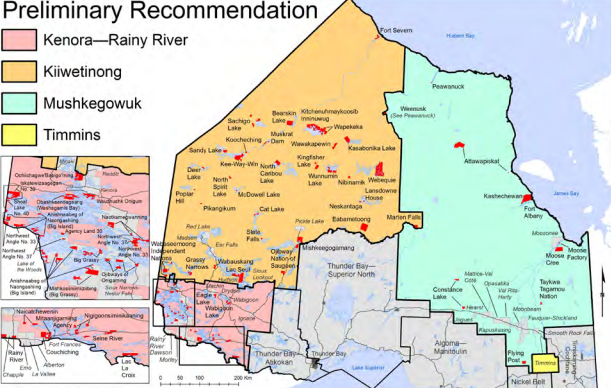THUNDER BAY -- Ontario's Liberal government plans to proceed with implementation of the recommendations of the Far North Electoral Boundaries Commission.
If the legislature passes a bill to be introduced this fall, northern Ontario will gain two additional ridings in time for next year's provincial election.
The new riding of Kiiwetinoong, which includes the northern portion of the current riding of Kenora-Rainy River, will have a majority Indigenous population. To the east, the new riding of Mushkegowuk will be predominantly Francophone with a strong Indigenous component as well.
The populations of the two new ridings will be significantly smaller than the average population of 110,000 for Ontario's electoral districts, and the average population of 76,000 for electoral districts in northern Ontario.
Kiiwetinoong's population would be 33,000, while Mushkegowuk's would be 30,000. The ridings the new electoral districts are to be carved from, Kenora-Rainy River and Timmins, would also see their populations reduced.
The Commission, a majority of whose five members are Indigenous, said in its final report released Tuesday that it had heard repeatedly during public consultations that "representation of Indigenous people should be a factor of particular importance."
It addressed the issue of voter parity, saying "there is legislative and political recognition of the fact that voter parity must not prevent the addition of new (electoral districts) that are necessary in order to achieve effective and fair representation in the Far North."
Emmett Macfarlane, a political scientist at the University of Waterloo, said questions have been raised in the past as to whether the right to vote includes a general right to parity in voting power. "That's a fancy way of saying that my vote in a city like Waterloo should be worth roughly the same as a vote from Toronto or as a vote from a rural riding."
Macfarlane, whose main areas of study include the Canadian constitution and governance issues, told Tbnewswatch.com that when there are ridings that have 150,000 people and others that have 70,000 or fewer, it can raise the issue of vote parity.
In a 1981 case involving Saskatchewan, the Supreme Court ruled that there can be justification for ridings up to 50 per cent smaller than average, but Macfarlane said what's not clear is "how far you can push that....My understanding is that (in) the proposal the government has accepted now in Ontario, the ridings vary as much as 70 per cent."
Macfarlane feels that leads to an open constitutional question: "At what point are we pushing it too far and undermining the right to vote?"
He believes the provincial government's current plan is based on good intentions and that the government could make a strong case in court for the need to give special consideration to representation for Indigenous and Francophone minorities.
But Macfarlane said it would be even safer for the government, in a legal sense, to enact a provision for specific Indigenous representation in the legislature by having some Indigenous seats set aside.
"That would actually be an effective amendment to the provincial constitution but one that the Ontario government could do on its own," he suggested.
While Macfarlane said such a provision would be less likely to be successfully constitutionally challenged, he speculated that it could also prove to be a more politically sensitive option.
In its report, the Electoral Boundaries Commission said it is unanimously convinced that its decision is consistent with the requirements of the Charter of Rights and Freedoms.
